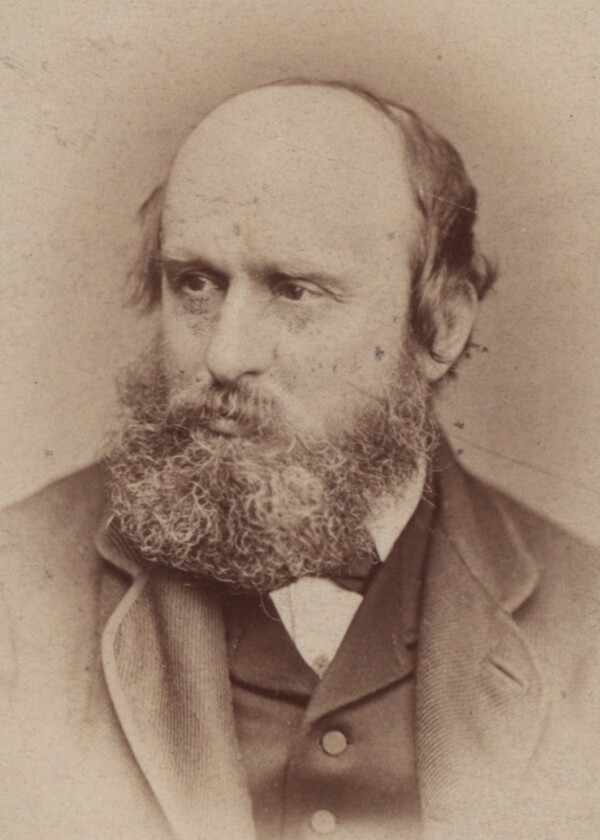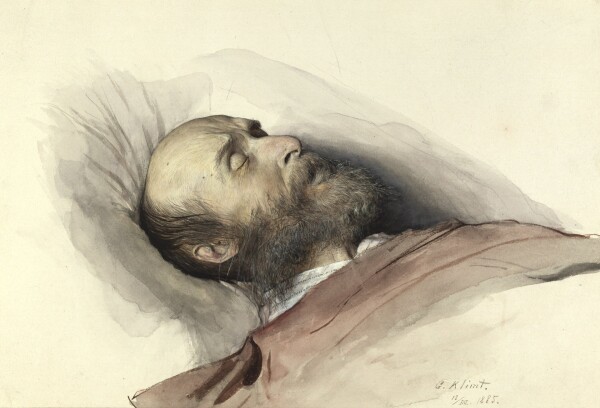Rudolf Eitelberger

Rudolf Eitelberger photographed by Ludwig Angerer, around 1880-1885
© Wien Museum
©

Gustav Klimt: Rudolf von Eitelberger on his Deathbed, 1885, Wien Museum
© Wien Museum
Rudolf Eitelberger, a philology and art history scholar, initiated the founding of the Austrian Museum of Art and Industry in 1864 and the Vienna School of Arts and Crafts in 1867, which would later be attended by Gustav Klimt. His activities and efforts contributed significantly to the success of Vienna’s school of art history and that of Austria’s art industry in general.
Rudolf Eitelberger Edler von Edelberg was born in Olmütz in Moravia (now Olomouc, Czech Republic) in 1817, where he studied law. He later studied classical philology and art history in Vienna. In 1847, he became the first art history lecturer who qualified for a professorship in Vienna. He was appointed associate professor only five years later and became a full university professor for art history in 1864.
A New Museum
Through his part-time work as an art expert for the Wiener Zeitung, Eitelberger became a member of the exhibition committee that was responsible for representing the fine arts division at the 1862 World’s Fair in London. Eitelberger was greatly impressed with the international art exhibition. According to his personal notes, he also acquainted himself with the institution of the South Kensington Museum – both a museum and an art school – during his stay. Eitelberger perceived the combination of exhibition spaces with educational lectures as an ideal model which Austria should copy. In 1862, he wrote down his idea in a manifesto and presented his proposal to Archduke Rainer, among others. The same year, Emperor Franz Joseph I approved the founding of a museum to “promote the development of good taste.” Eitelberger was appointed the first director of the Imperial-Royal Austrian Museum of Art and Industry (now MAK – Museum of Applied Arts) and the Vienna School of Arts and Crafts.
Eitelberger as a Catalyst
In addition to initiating the founding of the new Imperial-Royal Museum of Art and Industry and the School of Arts and Crafts, Eitelberger also suggested the creation of a Central Committee for Artworks and Historic Monuments, he was involved in the reorganization of the Academy of Fine Arts and he organized the first international art historians’ conference in Vienna. Furthermore, he was the editor of the Mitteilungen der k. k. Zentralkommission zur Erforschung und Erhaltung der Kunst- und historischen Denkmale (Communications of the Imperial-Royal Central Committee for the Study and Maintenance of Artworks and Historic Monuments) and published the series Quellenschriften für Kunstgeschichte und Kunsttechnik des Mittelalters und der Renaissance (Source Texts for Art History and Artistic Techniques of the Middle Ages and the Renaissance) from 1871.
One of Klimt’s First Patrons
Eitelberger actively promoted Klimt and his brother Ernst as well as Franz Matsch during their studies and in the first few years of their artistic careers. A letter written by Franz Matsch reveals that Eitelberger personally asked the three young artists to exhibit their theater curtain for the Stadttheater Reichenberg at the Imperial-Royal Austrian Museum of Art and Industry for a few days in 1883 before handing it over to their clients.
One hand-written document is of special interest with regard to the professional relations between the young artists and Eitelberger: a letter addressed to Rudolf Eitelberger that was written by Franz Matsch in 1884 and also signed by the Klimt brothers. It is so far the only known handwritten document that contains a written presentation of the program of the so-called “Künstler-Compagnie.” Furthermore, the three artists ask the art historian to help them get commissions in Vienna, the capital of the Austrian Empire. According to later reports, Eitelberger consequently recommended Franz Matsch and Gustav and Ernst Klimt to the architect Carl von Hasenauer, who built the Hermesvilla and the Imperial-Royal Court Theater (now Vienna Burgtheater).
The Last Portrait
Rudolf Eitelberger died in Vienna in April 1885. Prior to his funeral, Gustav Klimt created a portrait of the art historian on his deathbed. Eitelberger’s family bestowed this watercolor, called Rudolf von Eitelberger on His Deathbed (1885, Wien Museum), upon the city of Vienna in 1909, together with further objects from Eitelberger’s estate, on the condition that his legacy as a writer be made accessible for “use and processing by expert scholars.”
Literature and sources
- Rudolf Eitelberger: Österreichische Kunst-Institute und kunstgewerbliche Zeitfragen, Vienna 1879.
- Wiener Zeitung, 21.04.1885.
- N. N.: Festschrift zur Eröffnung des neuen Museums-Gebäudes am 4. November 1871, Vienna 1871.
- Österreichische Akademie der Wissenschaften (Hg.): Österreichisches Biographisches Lexikon 1815–1950, Band 1, Vienna 1994.
- Felix Czeike (Hg.): Historisches Lexikon Wien, Band 2, Vienna 1993, S. 159-160.
- Eva Kernbauer, Kathrin Pokorny-Nagel, Raphael Rosenberg, Julia Rüdiger, Patrick Werkner, Tanja Jenni (Hg.): Rudolf Eitelberger von Edelberg. Netzwerke der Kunstwelt, Vienna - Cologne - Weimar 2019.
- Brief von Franz Matsch in Wien an Rudolf Eitelberger in Wien, mitunterschrieben von Ernst und Gustav Klimt (02.02.1884). H.I.N. 22.439, .
- Neues Wiener Journal, 25.04.1909, S. 3-4.
- Ursula Storch (Hg.): Klimt. Die Sammlung des Wien Museums, Ausst.-Kat., Vienna Museum (Vienna), 16.05.2012–07.10.2012, Vienna 2012, S. 200.

